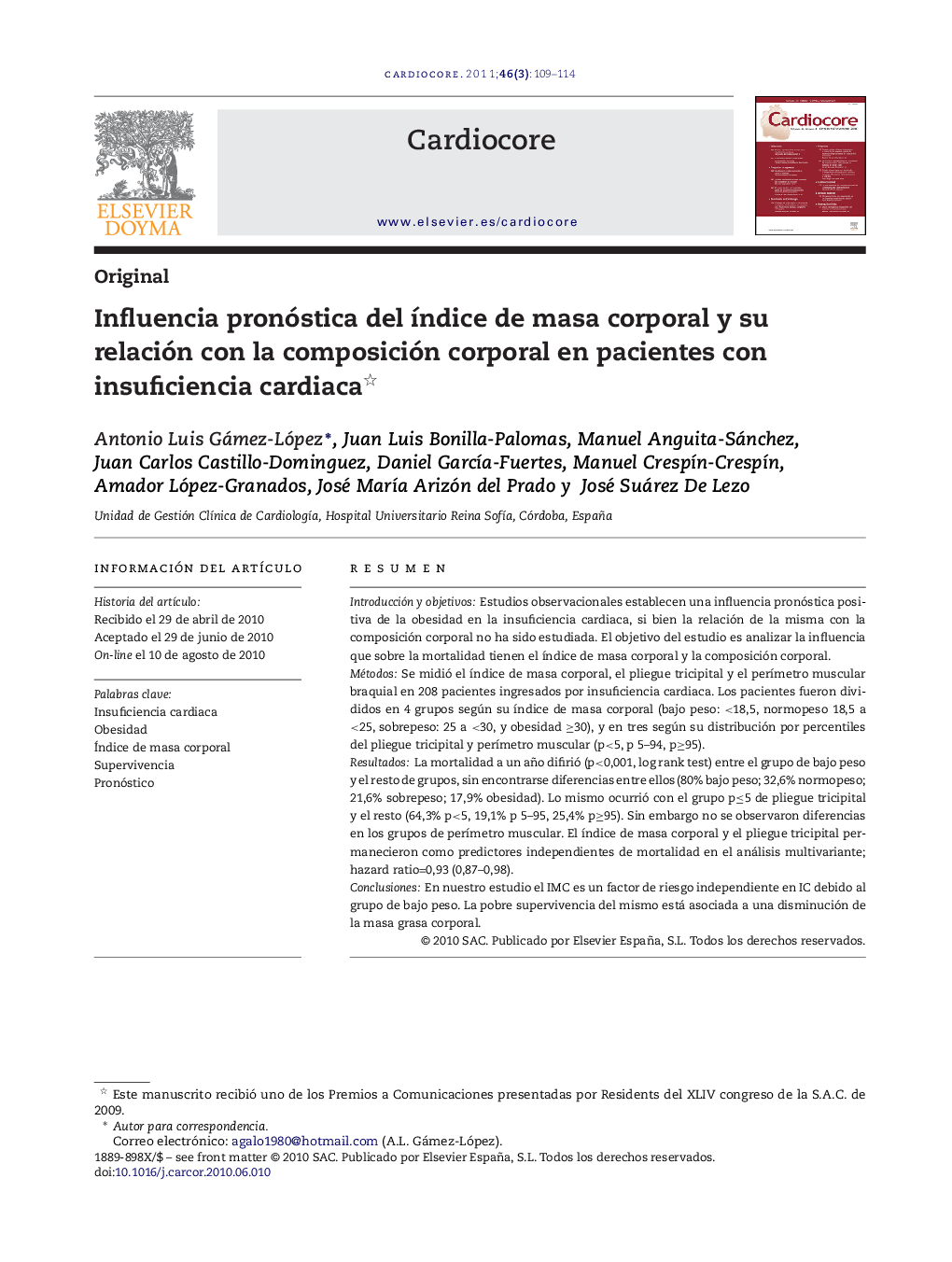| Article ID | Journal | Published Year | Pages | File Type |
|---|---|---|---|---|
| 2897466 | Cardiocore | 2011 | 6 Pages |
ResumenIntroducción y objetivosEstudios observacionales establecen una influencia pronóstica positiva de la obesidad en la insuficiencia cardiaca, si bien la relación de la misma con la composición corporal no ha sido estudiada. El objetivo del estudio es analizar la influencia que sobre la mortalidad tienen el índice de masa corporal y la composición corporal.MétodosSe midió el índice de masa corporal, el pliegue tricipital y el perímetro muscular braquial en 208 pacientes ingresados por insuficiencia cardiaca. Los pacientes fueron divididos en 4 grupos según su índice de masa corporal (bajo peso: <18,5, normopeso 18,5 a <25, sobrepeso: 25 a <30, y obesidad ≥30), y en tres según su distribución por percentiles del pliegue tricipital y perímetro muscular (p<5, p 5–94, p≥95).ResultadosLa mortalidad a un año difirió (p<0,001, log rank test) entre el grupo de bajo peso y el resto de grupos, sin encontrarse diferencias entre ellos (80% bajo peso; 32,6% normopeso; 21,6% sobrepeso; 17,9% obesidad). Lo mismo ocurrió con el grupo p≤5 de pliegue tricipital y el resto (64,3% p<5, 19,1% p 5–95, 25,4% p≥95). Sin embargo no se observaron diferencias en los grupos de perímetro muscular. El índice de masa corporal y el pliegue tricipital permanecieron como predictores independientes de mortalidad en el análisis multivariante; hazard ratio=0,93 (0,87–0,98).ConclusionesEn nuestro estudio el IMC es un factor de riesgo independiente en IC debido al grupo de bajo peso. La pobre supervivencia del mismo está asociada a una disminución de la masa grasa corporal.
Introduction and objectivesObservational data suggest a protective effect of obesity in heart failure but the relationship with body composition has not yet been studied. The objective of our study is to examine the prognosis influence of body mass index and body composition.MethodsBaseline body mass index, tricipital skin-fold and brachial muscle circumference were recorded in 208 patients admitted due to heart failure. They were divided into four groups according to BMI: low weight (<20.5), normal weight (20.5 to <25.5), overweight (25.5 to <30), and obese (≥30) and in three groups according to tricipital skin fold and brachial muscle circumference (p<5, p 5–94, p≥95).ResultsThere was a difference in the mortality rate at 1 year (P<0.001) between low-weight patients and the other groups, with no differences between them: 80% for low-weight patients, 32.6% for normal-weight patients, 21.6% for overweight patients, and 17.9% for obese patients. The same was observed between p<5 tricipital skin fold patients and the other groups (64.3% p<5, 19.1% p 5–95 and 25.4% p≥95, P=0.002). No differences were observed between brachial muscle circumference groups. After adjusting for different prognosis variables, body mass index and tricipital skin fold remained as independent predictor of reduced mortality at 1 year in multivariate analysis (Hazard ratio=0.93 [0.87–0.98]).ConclusionsIn our study, body mass index is an independent risk factor in heart failure due to the group of low weight patients. The poor survival of this group is associated with a decrease in body composition characterised by a decreased body fat mass.
